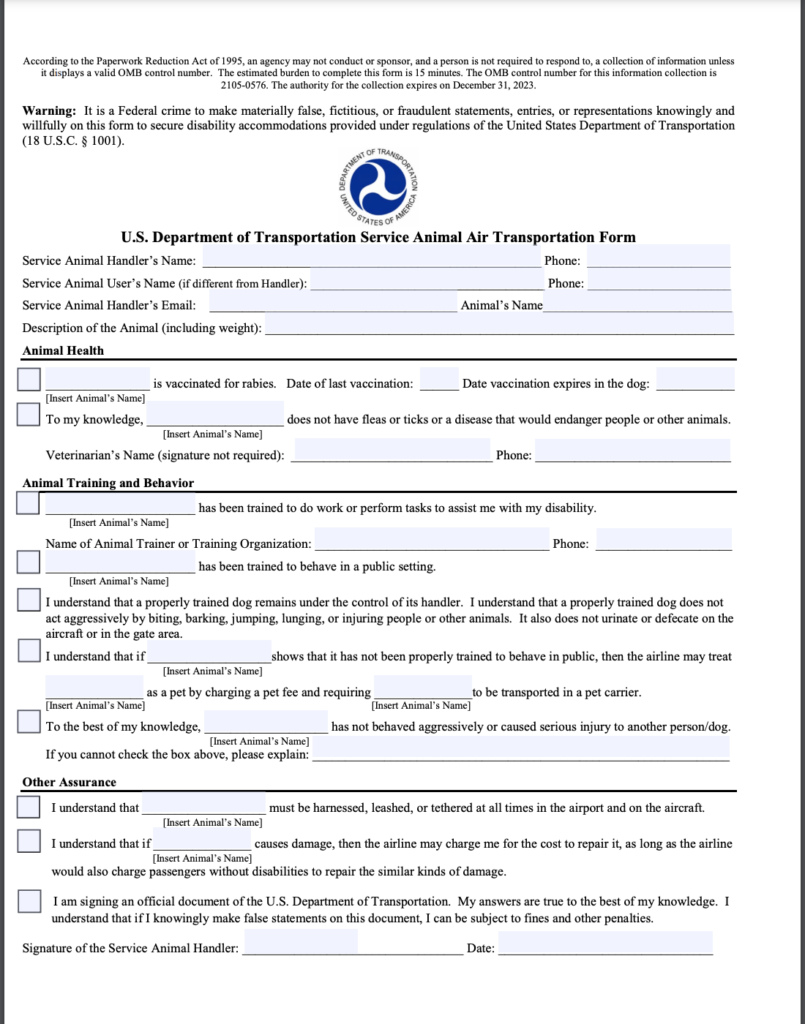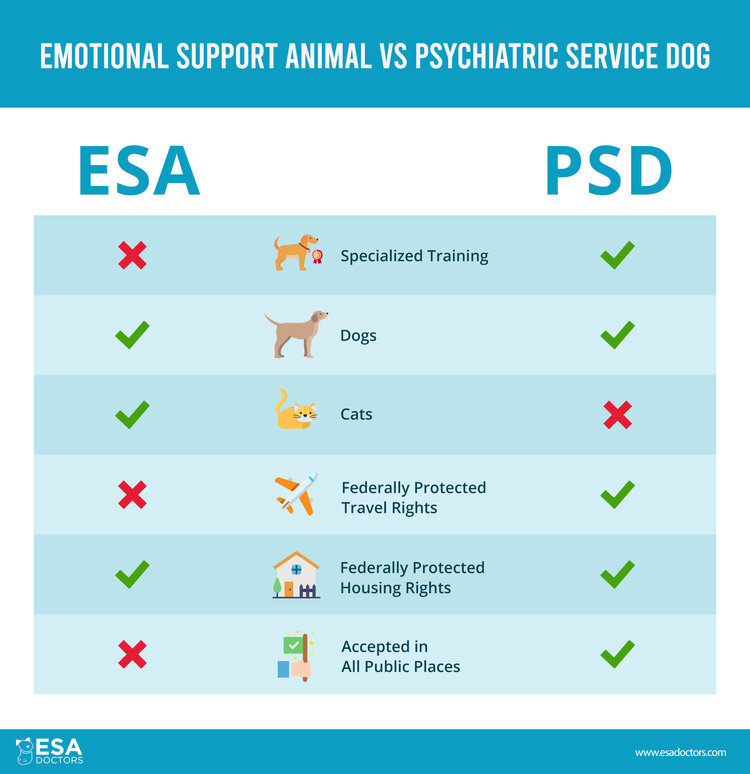It’s possible to turn your emotional support animal into a psychiatric service dog if you’re willing to put in the work to train your dog, and your health condition requires a dog to perform specialized tasks. As a PSD owner, you get additional rights above the housing benefits ESAs have, including air travel and ADA rights that let you bring your dog to public places.
Here are the steps to turn your ESA into a psychiatric service dog:
- Confirm you need your ESA to perform trained tasks
Both service dog owners and ESA owners have disabilities, but service dog owners need their dogs to perform a task relating to their condition.
- Work with a therapist if needed
For peace of mind, you can request a PSD letter from your healthcare professional, or we can help connect you to one here.
- Train your dog
Train your dog by yourself or with the help of a professional trainer to perform a task that directly assists with your condition.
- Test your service dog’s manners
Make sure your dog can be calm, alert, and well-behaved in various busy public settings, like airports and stores.
- Get service dog accessories
You can optionally outfit your dog with vests, tags, harnesses, and ID cards to signal that your dog is an on-duty service dog.
To learn more about psychiatric service dogs, keep reading. We’ll give the answers to questions ESA owners commonly have about making the change towards service dog ownership.
What are the legal rights of emotional support animals versus psychiatric service dogs?
Psychiatric service dogs have broad public access rights under the Americans with Disabilities Act (ADA), while ESAs do not. A PSD, for the most part, can go anywhere the public can go. That means a PSD can accompany their handler at a store, library, arena, hotel, or beach that prohibits dogs.
Both PSD and ESA owners have rights under the Fair Housing Act (FHA), allowing them to live with their animals in most housing types without paying fees, even in buildings prohibiting pets. PSDs also have special rights when it comes to flying on planes. They can board the cabin free of charge if you complete the DOT Service Animal Transportation Form. ESAs, on the other hand, do not have any air travel rights in the U.S.
What’s the difference between my emotional support animal and a psychiatric service dog?
The main difference is that a PSD must be trained to perform tasks related to the owner’s disability. By contrast, ESAs do not require any specialized training. ESAs provide comfort for their owners just by being present during times of difficulty. ESAs can also be a wide range of animals, while psychiatric service animals can only be trained dogs.
To further understand the difference between an ESA and a PSD, the ADA gives the following example: If a dog has been trained to sense an imminent anxiety attack and takes specific action to help avoid or mitigate the attack, then it would be a psychiatric service dog. However, if the dog is used to comfort a person’s anxiety just through its presence, it would not be considered an ADA service dog and is more likely an emotional support animal.
How do you qualify for a psychiatric service dog versus an emotional support animal?
Just like with an ESA, the owner of a PSD must have a mental health condition that limits their function in a major life activity such as working, sleeping, or learning. PSD and ESA owners both use their assistance animals to help them deal with conditions like depression, anxiety, PTSD, autism, learning disabilities, and phobias.
However, to qualify for a PSD, you also need a dog that has been fully trained to perform a specialized task that directly helps with your condition. PSDs are used for an incredible variety of work, including the following:
- Reminding their handler to take medication
- Interrupting episodes such as crying, dissociation, flashbacks, and nightmares
- Interrupting harmful actions, such as scratching, picking, and self-harm
- Providing pressure and tactile stimulation to calm
- Grounding and orienting the handler during panic attacks
- Lying on the handler during psychotic episodes
- Applying gentle pressure with teeth or nuzzling to disrupt psychiatric episodes
- Interrupting repetitive behaviors
- Helping the handler maintain a stable routine
Can my emotional support animal become a psychiatric service dog?
Whether your emotional support dog can potentially become a psychiatric service dog depends on several factors, including the following:
- Temperament: Your dog needs to be calm, focused, and able to work in public settings without being distracted or reactive to other people, animals, or environmental stimuli.
- Trainability: Your dog must be capable of learning and reliably performing specific tasks related to your disability.
- Age: Younger dogs (typically 1–2 years old) are often ideal candidates as they’re mature enough to focus but young enough to learn easily. While older dogs can be trained, they may take longer to learn new behaviors.
- Physical Capability: The dog needs to be physically able to perform the required tasks. Consider your specific needs — if you need the dog to perform body positioning tasks, they need to be the appropriate size and strength.
- Health: The dog should be in good health without any chronic conditions that could interfere with their work.
- Current Behavior: If your ESA already shows anxiety, aggression, or strong prey drive, they might not be suitable for service work.
- Sociability: PSDs work in public environments so they need to get along well with other humans and animals.
Keep in mind that transitioning from an ESA to a service dog requires extensive training — either with a professional service dog trainer or through an owner-training program with professional guidance. The process typically takes 6–12 months or longer, depending on the tasks needed and the dog’s learning pace.
How can I train my ESA to become a PSD?
You can train a service dog on your own with consistent routine, patience, and discipline. Training your ESA to become a psychiatric service dog does not require professional training or certification by an organization. While there are organizations and professional trainers available that can help with training, the ADA allows handlers to do the training themselves. However, if you’re inexperienced with dog training or get stuck when training your dog, calling on the help of a professional is well advised.
Keep in mind there is also no official certification process for the completion of training for psychiatric service dogs, but there are organizations that promote unofficial guidelines and standards. Your dog is not considered a full-fledged service dog until it can reliably perform its special tasks in all types of public environments.
How does someone verify whether you have a PSD or an ESA?
If you own a PSD and enter a public space such as a store, the staff members are allowed to ask you two questions:
- Is the psychiatric service dog required because of a disability?
- What work or task has the PSD been trained to perform?
The staff members cannot demand any written documentation, insist on the PSD to demonstrate its task, or ask intrusive questions about your disability.
Psychiatric service dogs are not required to wear vests, ID tags, or specific harnesses, and their owners do not need to carry ID cards or certifications. However, many PSD owners use these items voluntarily to help their dogs manage public interactions.
PSD owners, in particular, can be self-conscious about their invisible disability and use service dog gear to ward off potentially embarrassing inquiries. The DOT has also stated that airlines can weigh the presence of service dog gear like harnesses, vests, and tags to determine whether a dog is a PSD.
If you’re flying with a psychiatric service dog, airlines can require that you submit a form created by the DOT prior to your flight. The form requires PSD owners to certify various statements, including the following:
- The PSD has been individually trained to do work or perform tasks for the owner.
- The PSD has been trained to behave in public.
- The PSD will be under the handler’s control at all times.
- If the PSD misbehaves, the airlines can elect not to treat the PSD as a service animal.
- The handler is liable for damages caused by their PSD.
The handler must also certify that the PSD is vaccinated. The form is self-certifying, meaning the handler must sign the document and make all the certifications themselves. Lying on the form can result in fines and other penalties under Federal law. Below, you can find a sample of the DOT Service Animal Transportation Form.

To prove you have an emotional support animal, you need an ESA letter from a licensed healthcare professional. Landlords can request a tenant present a signed letter from a licensed therapist before agreeing to accommodate an ESA.
Is a PSD right for me as a current ESA owner?
The short answer is maybe. A PSD is not suitable for all ESA owners, and not all ESAs can become PSDs. The answer depends on a few factors because for an animal to qualify as a PSD, both the owner and the PSD have to meet certain legal criteria.
If you’re considering training your emotional support animal to become a psychiatric service dog, there are many things to consider. ESAs and PSDs are often used by people with the same kinds of conditions, but most individuals with a mental illness do not have a condition that requires the involvement of a task-trained service animal.
However, if you’re an ESA owner and have a condition where a trained service dog could provide assistance, an ESA can be trained as a PSD. You may even have an ESA that is already performing specific tasks to help you manage your mental illness or learning disability.
Remember, a PSD must be fully task-trained, and the task must directly relate to the owner’s psychiatric disability. In addition, if the PSD is being taken into public areas and on planes, it must be trained to cope with high-stress environments filled with other people, children, and animals. Not all emotional support animals will have the temperament to do so.
Training a dog to become a PSD is not an easy endeavor, but it can be done with consistent effort. If you think you may qualify for a PSD but are unsure, the best place to start is to discuss your mental health needs with a licensed mental health professional.
Click the button above to get your PSD Letter






I have PTSD anxiety and depression , I have a very hard time being out in public especially if there are many people around I am almost in panic mode if people are behind me or if people are in the same isle in the store , right now my dog is a ESA dog the stores have been kind enough to allow her to be with me since she is a small dog and kept in a Carry pouch for dogs would Candy quality as a PSD dog
ESAs are not the same as PSDs. The animal can only be a PSD if the handler requires the animal to perform a specialized task or job that assists with the disability. If the animal helps with mental health conditions just through its presence, then it is more suited as an emotional support animal.
I have diagnosed PTSD. My dog is my anchor if I go out in public. I need full access for him.
I’m wondering, where do I go to get legal documentation required to make my dog a PSD? Is there an establishment or place that will give me the proper paperwork to finalize her training as a service animal? or is all I need a letter from a therapist???
PSDs are not required to have documentation. However, some PSD owners will obtain a PSD letter: https://esadoctors.com/how-to-get-a-psychiatric-service-dog-letter/
It should also be noted that just because your dog does something that helps you, it does not make it any kind of service dog. Even if the dog “alerts” to you, it must be shaped/trained into a specific response and then proofed. The dog will also need to undergo public access training to be considered a service dog of any kind. I’m a service dog handler of 9 years.
Excellent information. Thank you for posting. I will share the information. I knew that the Airlines had changed their rules in allowing ESA dogs due to many people that used their unruly pets as excuses, and became a public hazard for passengers. I was not aware that there was a specific PSA. I think it is excellent, as so many people with legitimate diagnoses have been harmed by the change in airline industry. I believe there will be less deception if a licensed doctor must provide a letter with diagnosis as requirement. I am inclined to believe there will be less corruption, and legitimate doctors will not be willing to put their medical doctor licences, and careers on the line.
Thank you.
Thank you! If you would like additional information on the paperwork required to fly with a PSD, we recommend this article: https://esadoctors.com/dot-service-animal-air-transportation-form/
I am 76 yrs old and have nightmares and night terrors. I often throw myself to the floor during dreams. Because of my age this is very dangerous. I have tried bed rails but they are not convenient.
For about a year now my 8lb dog has been waking me if I am having nightmares. He is persistent and does not let me fall asleep again until I am fully awake . I have not had any ‘sleep falls’ since he started this. I have come to depend on his assistance. Can his assistance be considered a PSD? I don’t travel much but it would be reassuring to have him with me. Is it too much hassle to try to get him approved.
That could be a task provided by a psychiatric service dog. You would also need to have a “disability” that the dog assists with, as such term is defined under the DOT’s air travel rules. If you need a licensed healthcare professional to evaluate whether you have a psychiatric disability, we can help you here: https://esadoctors.com/psychiatric-service-dog-letter/
I was able to train my dog. She remains focused when we are traveling. She is only 5 yrs old, but she is right for the job. She has a carrier which keeps her away from children wanting to pet her since she only weighs 8 lbs.
I have limited mobility and suffer from depression and claustrophobia
my dog helps me to relax and stay calm during my flight. I really for need her by me beside my anxiety my body and face become tense due
to my bell palsy. I think mental health issues should be taken under consideration and I don’t think I can fly without her
If your dog performs a task or job that helps with your disability during the flight, then it may be eligible as a psychiatric service dog which is allowed to board the cabin of airplanes.
Most out be a dog..I have a cat that is quite astute.. when I have panic attacks he comes and will lay his body on my chest and it relaxes my breathing.. he knows! He completely reads my energy just before it starts and comes and distracts me.. he is ESA not..I tried to find him training as a therapy animal to bring to hospitals.. would help me to help others.. but there’s no training for cats.. it seems to be only dogs.. but you can absolutely train a cat.. the right cat.. filled out questionaire.. but it only mentioned dog so I didn’t proceed
Unfortunately only dogs are allowed to be psychiatric service animals under ADA and ACAA rules.
One of the questions I can be asked about my PSD is “What work or task has the PSD been trained to perform?” How can I respond without revealing my medical details? For example, if my PSD is trained to interrupt self-harm, I don’t want to reveal that to a stranger.
In responding to this question you do not have to reveal specifics about your condition. You may be able to say something to the effect that your dog has been trained to interrupt certain psychiatric episodes.